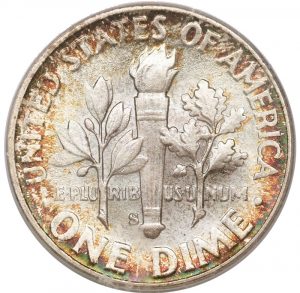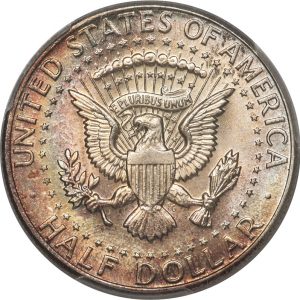
Pocket change coin values can be lucrative. The United States Mint has produced lots of valuable treasures over the years. Much is still in circulation. A dedicated collector who scours bankrolls and screens every coin with a fine-tooth comb can reasonably expect to land a valuable find on occasion.
Patience is key and so is a keen eye!
Celebrity Finds
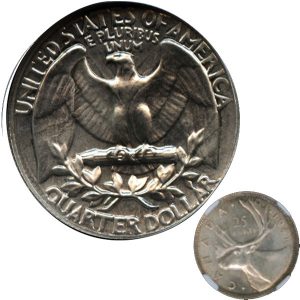
COURTESY OF MIKE BYERS
Odd coins are the curiosity of nearly anyone, even celebrities. Take Shawn Pyfrom, best known from Desperate Housewives, who notched headlines when he found one of the first 2019-W Lowell National Historical Park Quarters. The coin was the first of 10 America the Beautiful Quarters struck at the West Point Mint in 2019 and 20 20 with a “W” mintmark. Just two million pieces of each were minted and distributed only through circulation; none were offered in U.S. Mint collector sets.
One-Off Coins
Rarities the U.S. Mint wasn’t supposed to strike are intriguing. Consider the 1970-S proof Washington quarter overstruck on a 1941 Canadian quarter that shows remnant detail from the original Canadian design. The quirky coin went viral in 2016 when it hit eBay for $35,000.
“The way the media portrayed this unique mint error made it seem like a lucky collector could find another one in their ashtray or couch,” Byers shares. “Coin stores were inundated with phone calls and emails from people claiming they had discovered one.”
Dealers authorized to submit coins to be authenticated and graded were deluged by requests to submit potential discoveries.
“This mint error was struck in proof by the San Francisco Mint deliberately over a 1941 Canadian quarter and is the only one known to date,” says Byers. “Collectors should not get discouraged when they realize that they don’t have another one but should keep searching for silver coins and other potential mint errors in their coin roll hunting endeavors.”
Byers explains that searching for error coins has become mainstream and thousands of collectors are actively searching rolls and bags for errors.
“A few broadstrikes, off-centers, double strikes (in collar) and off metals have been known to be found in sealed proof sets,” Byers reveals.
“Proof errors are aggressively sought after by many error collectors.”
Modern Varieties & Errors
Finding modern errors or die varieties can be difficult.
Bill Fivaz, who authored Cherrypickers’ Guide to Rare Die Varieties of United States Coins, says United States Mint quality control protocol has improved in recent years.
“With the new die/coin making process several years ago, truly collectible varieties and errors are becoming increasingly difficult to find in pocket change or roll searching,” Fivaz remarks. “Errors such as off centers, brockages, broadstrikes, etc. are virtually non-existent as they are culled out by the armored car companies and returned to the mint or destroyed.” This doesn’t mean there aren’t older peculiarities in pocket change. “Varieties such as the 1960 and 1970-S small-date cents, some repunched mintmarks and minor doubled dies might be found by the astute seeker,” Fivaz continues.
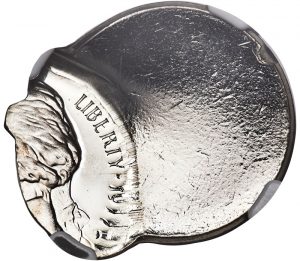
COURTESY OF HERITAGE AUCTIONS HA.COM
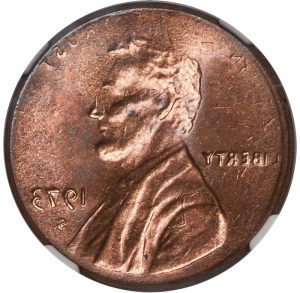
COURTESY OF HERITAGE AUCTIONS HA.COM
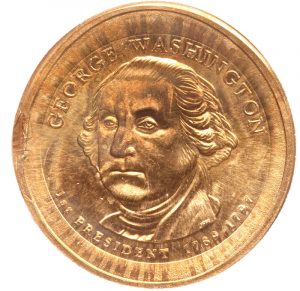
COURTESY OF HERITAGE AUCTIONS HA.COM
He also says collectors can land pieces that were struck through grease, which obscures portions of the design or coins with laminations. This type of error is usually rather minor, which makes the coins less valuable. A few scarce modern varieties include the 1969-S doubled die Lincoln cent, 1972 doubled die Lincoln cent, 1982 no mintmark Roosevelt dime, 1983 doubled die reverse Lincoln cent, 1984 doubled ear Lincoln cent, 1992 close “AM” Lincoln cent and 1995 doubled die Lincoln cent.
Determining credible varieties and errors from mere post-mint damage may seem tedious to collectors new to this arena of numismatics. Fivaz says expanding your knowledge can vastly improve your confidence when plucking errors and varieties from circulation. A key lesson for any collector is understanding how coins are made.
“By knowing this, if a collector finds a coin they think is an error or variety, they can ask themselves, ‘Where in the minting process could this have happened?’” Fivaz suggests. “If they can’t answer this question, chances are it is not an error or variety.”
Fivaz also advises collectors to look through many coins and view damaged pieces, errors and varieties in-hand to better familiarize themselves with what these pieces really look like. “There’s no substitute for experience, once you’re armed with the proper knowledge,” he concludes.
Go for Bronze & Silver
The probability of making an unusual gold coin find is many times smaller than stumbling on bronze Lincoln cents or silver coinage from yesteryear.
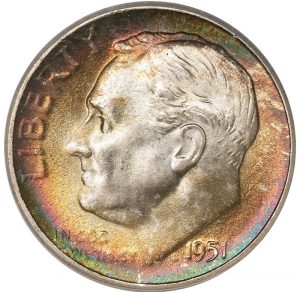
COURTESY OF HERITAGE AUCTIONS HA.COM
The 90% silver Roosevelt dimes and Washington quarters that were phased out in 1965 became notable prizes as bullion values continued to increase. Keep an eye out for pre-1965 dimes, quarters and half dollars. All of which are made from 90% silver compositions.
Don’t forget 35% silver Jefferson “wartime nickels” of 1942 through 1945, which are easily identified by their large mintmarks over the dome of Monticello on the reverse. The 40% silver Kennedy half dollars of 1965 through 1970 are also worthwhile treasures. Any of these silver coins are likely to turn up searching rolls, bags and boxes from the bank.
Bronze and steel Lincoln cents also warrant attention. The 1943 bronze Lincoln cent is a coveted rarity worth $100,000 and up. It rolled off the presses when officials switched to a zinc-plated steel planchet to save copper for the war effort. The flub occurred in reverse in 1944, when a handful of steel cents were mixed in with the standard bronze output and now realize around $75,000.
Against protest from the copper lobby, Congress approved a zinc-based Lincoln cent in 1981, the last full year circulating strikes of the coin were produced in a 95% copper, 5% zinc format.
Through 1982, the United States Mint transitioned to a copper-plated zinc composition for Lincoln cents. This resulted in seven regular-issue varieties of different metal compositions and date sizes. The standard weight for a bronze Lincoln cent is 3.11 grams. A typical zinc cent registers 2.5 grams. Remember this when sorting through 1982 pennies in search of the copper variants.
The biggest bronze prizes from 1982 aren’t run-of-the-mill copper issues.
In 1982, the Denver Mint made at least two transitional off-metal errors struck on bronze by the small-date obverse die. The elusive 1982-D small date bronze cent was first reported by a collector in 2016 and sold for $18,800 at auction; news of a second example came along in 2019, with that piece realizing $10,800.
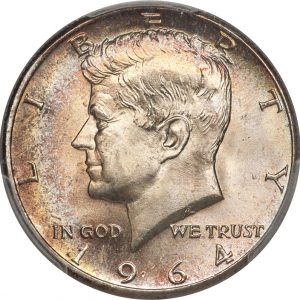
COURTESY OF HERITAGE AUCTIONS HA.COM
A few bronze Lincoln cents dated 1983 and 1989 have also been found, each selling at auction for a few thousand dollars apiece. A small, unknown quantity of 1965-dated Roosevelt dimes and Washington quarters were struck on 90% silver planchets intended for retirement with the 1964 output. The 1965 silver dimes sell for $3,500 or more at auction while the 1965 silver quarters bring around $7,000. The 90% silver dime planchet weighs 2.5 grams, while the 90% silver quarter planchets tip scales at 6.25 grams.
Storied Key Dates Still Stalk Circulation
Many collectors romanticize the days of the mid-20th century when coins such as Standing Liberty quarters and Walking Liberty half dollars comingled in circulation alongside Lincoln wheat cents, 90% silver Roosevelt dimes and Washington quarters, as well as the occasional Indian Head cent or Barber coin. Even collectors who recall searching through their pocket change in the 1950s or 1960s will recall the extreme difficulty of l anding any rare dates in circulation.
That doesn’t mean coveted coins weren’t out there then. Back in the day, some lucky collectors landed big shot rarities such as the 1909-S V.D.B. New online casino platforms are very popular nowadays. Such casinos can boast off a big selection of important functionalities, convenient design, and enoormous slot collection. If you will to know more about new casinos online, check out the review presented by Casinonongamstop specialists. and 1914-D Lincoln cents; 1916-D Mercury dime; 1916 Standing Liberty quarter; and 1932-D and 1932-S Washington quarters. The famed 1909-S V.D.B. Lincoln cent is identified by its “S” mintmark (San Francisco) under the year, 1909, and the designer’s initials, V.D.B. (Victor David Brenner), on the reverse.
To subscribe to COINage magazine click here. Story by Josh McMorrow-Hernandez.


